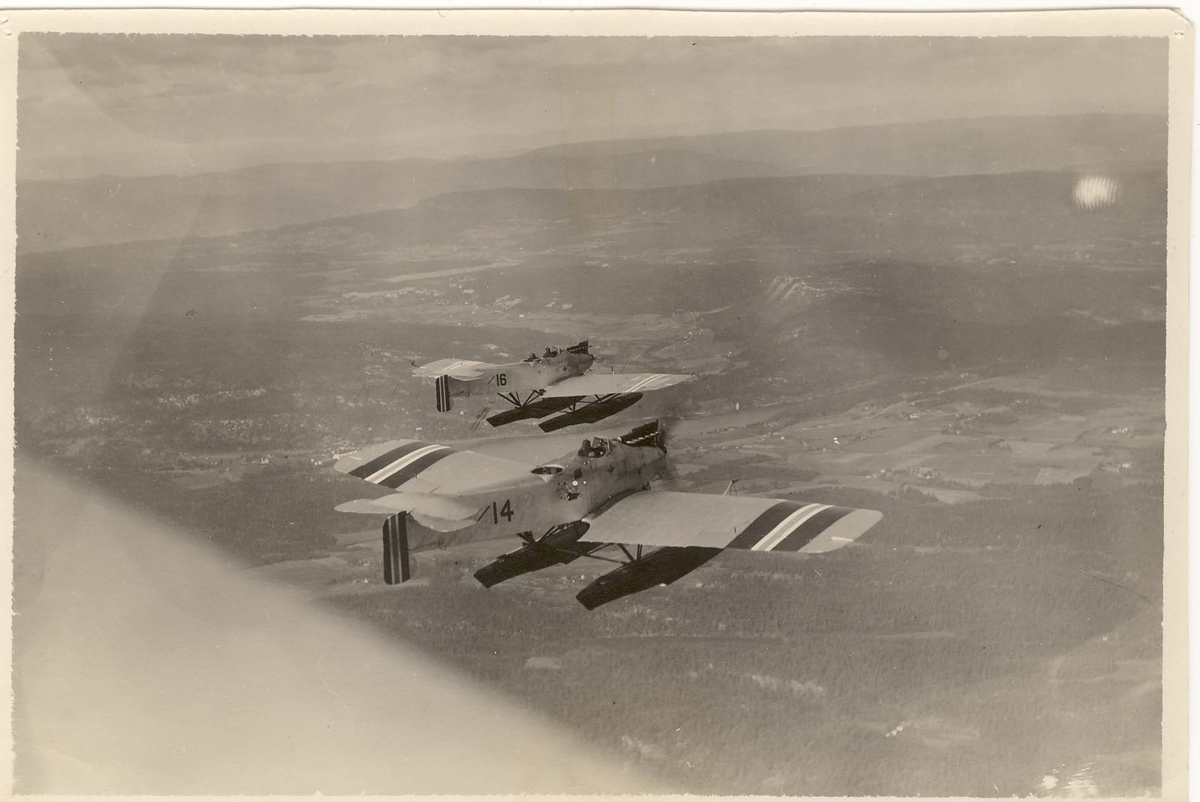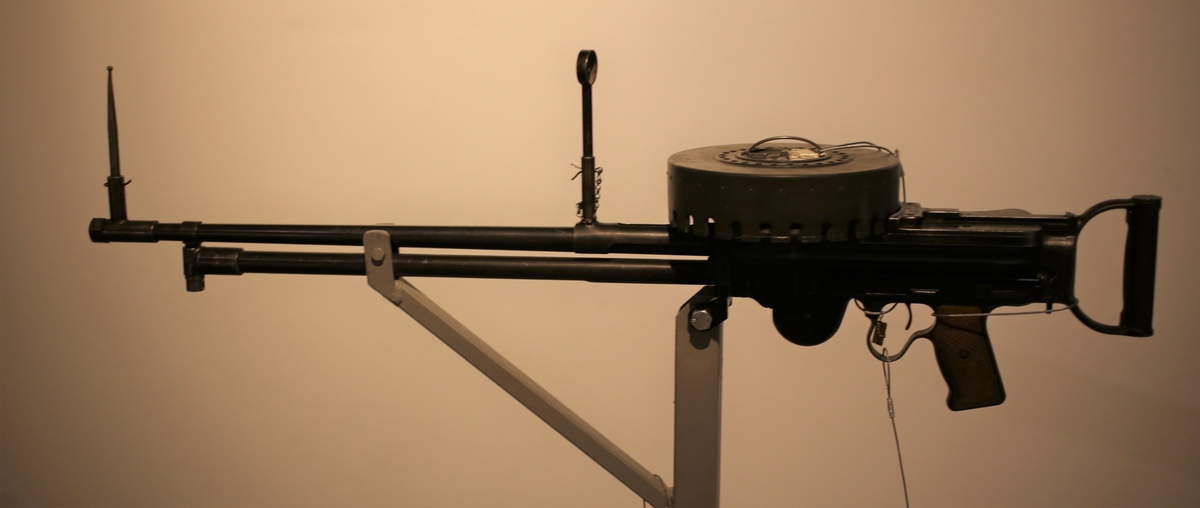
TYPE: Two to three seated reconnaissance monoplane
AMOUNT: 9x
3x WERE LICENSE BUILT IN NORWAY AT: Marinens Flyfabrikk, Horten and Kjeller
ARMAMENT
Spoiler
Primary armament
1x Vickers machinegun
-Placement: fixed, synchronised Vickers gun for the pilot on the right side, synced to shoot between the propeller blades

Length: 1.12 m
Barrel length: 720 mm
Cartridge: .303 British / 7.7 mm
Action: recoil with gas boost
Rate of Fire: 450 to 500 rounds/min
Muzzle Velocity: 744 m/s
Effective Firing Range: 2,000 m
Maximum Firing Range: 4,100 m (indirect fire)
Feed System: 250 round canvas belt
1x Flexible .303 Model 1914 British Lewis Machinegun****
-Placement: Flexible mounted on a gun wing, in the rear. as a turret
Designed: 1911
Manufacturer: Birmingham Small Arms Co. Ltd. Savage Arms Co.
Produced: 1913–1942
Mass: 13 kilograms
Length: 1,283 Millimeters
Barrel length: 673 Millimeters
Width: 114 Millimeters
Cartridge: .303 British
Action: Gas-operated long stroke gas piston, rotating open bolt
Rate of fire: 500–600 rounds/min
Muzzle velocity: 744 m/s
Effective firing range: 805 Meters
Maximum firing range: 3,200 Meters
Feed system: 47- or 97-round pan magazine
Secondary armament
60 Kilos of various mines
60 Kilos of various bombs
1x 50 Kilogram bomb
a smoke dispenser
TECHNICAL DATA
Wingspan: 15.7 Meter
Length: 11.0 Meter
Eigne: 1x 6 Cylinder Benz
Power: 220 HP
Crew: 2-3x
Propeller: 2-bladed fixed-pitch propeller
PERFORMANCE
Maximum speed: 160 km/h
Cruise speed: 125 km/h
Range: 750 kilometer
SERIAL NUMBER,TAIL NUMBER, TIME IN SERVICE & FATE
55 - F.52 25.10.1921 - 10.1932 Discarded 1932
56 - F.54 21.04.1922 - 30.07.1925 Wrecked by Kristiansand
57 - F.56 19.06.1922 - 24.07.1922 Wrecked by Valdersund
58 - F.58 04.07.1922 - 28.07.1926 Collided in the air over Kristiansand
62 - F.14 16.04.1923 - 25.07.1923 Wrecked in Horten harbour
63 - F.16 26.05.1923 - 18.11.1933 Discarded 1933
64 - F.18 10.08.1923 - 30.07.1928 Wrecked by Varnestangen
65 - F.20 29.08.1923 - 25.08.1933 Wrecked by Horten
69 - F.56 26.10.1923 - 05.07.1926 Wrecked by Kristiansand
HISTORY
After World War 1, there was a need for a renewal of the Norwegian military aircraft fleet. The old Marinens FLyfabrikk 5 did not become the scout plane one had hoped it would be, and it was therefore decided to look beyond Norway’s borders to find a new scout plane. The German Hansa Brandenburg W.29 had excelled operationally over the North Sea in the last year of the war, and in 1920 the factory was ready with a larger version called the W.33, with room for up to three passengers. It was possible to buy cheaper licenses for the W.33 and the aircraft could use the 220 hp Benz engines that the air force had already purchased at a reasonable price. This then became the workhorse of the Navy’s air force for a full 11 years! from 1922 to 1933. The 2,600 kilometer trip between Horten and Kirkenes was completed in less than two days, a total of 21 flying hours. This was noticed, also internationally. From 1924 the planes were built with 260 hp Mercedes engines, and several of them were built as three-seaters with the radio operator in an enclosed cockpit. Radio became standard. Some of the two-seaters were given dual controls/instruments and a blind flight hood, and were used as school planes.
Already on 25 October 1921, the first aircraft was ready from the aircraft factory in Horten, and three more followed in 1922. Two of these, F.56 and F.58, were sent on a demonstration tour along the Norwegian coast from Horten to Kirkenes and back in the summer of 1922. The F.56 had to made an emergency landing on land on the return trip due to problems with the fuel supply, but the F.58 returned unscathed.
The W.33 was built in small series at the Navy’s aircraft factory in Horten, a total of 25 aircraft. The last was delivered as late as October 1929. In 1928, the Navy also took over the Army Air Force’s fortress aircraft groups and thus gained access to five more W.33 Måke IIIs. One of these was built in Horten, the rest at Kjeller under the Navy’s license. The Navy also took over an Måke II that had been built at Norsk Aeroplanfabrik in Tønsberg, but this was not flown in the Navy’s air force. The planes were distributed to the air stations in Horten, Kristansand and Bergen, but have perhaps become as well known as participants in security and search operations on Svalbard and across the Arctic Ocean in connection with the North Pole expeditions. It was also used in Antarctica for whaling, herring removal along the coast and in search operations. In addition, they were used in civilian guise as mail planes on the Oslo-Gothenburg night mail route in 1931. Gradually, however, age began to take its toll, with several tragic accidents as a result. And in 1933 there was a stop, a flight ban was lifted on 21 November 1933 after another accident on 25 August. The planes were then stored in Kristiansand and Bergen until most were dismantled and burned in the mid-1930s. The last trip with Hansa Brandenburg W.33 happened as late as March/April 1936.
In short, the difference between the early and late version is the engine and color. The early version (Make/Måke II) is equipped the 220 HP Benz engine and has a greenish paint, while every plane delivered after 1924, which then is the late version (Make/Måke III) had the 260 HP Mercedes engine equipped and were painted in “armor grey” color.
ALBUM
Spoiler
coming soon - technical issues with IMGBB
SOURCES
Spoiler
https://www.norli.no/boker/dokumentar-og-fakta/historie-og-dokumentar/krig-og-historie/luftforsvarets-historie-fortalt-gjennom-75-gjenstander?
https://www.adlibris.com/no/bok/norske-militarfly-9788271286873?
Norsk marinehistorie : modeller som forteller - detaljert visning - Biblioteksøk
C.Owers - Hansa-Brandenburg Aircraft of WWI. Volume 3 - Monoplane Seaplanes /Centennial Perspective/ (19)
- Yes
- No

